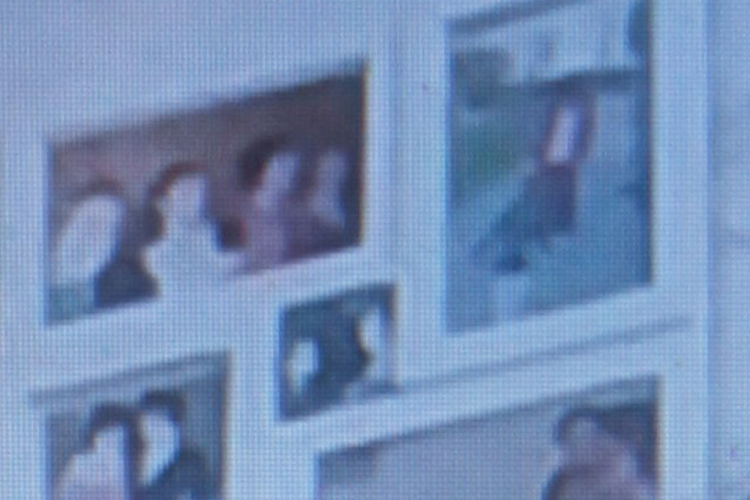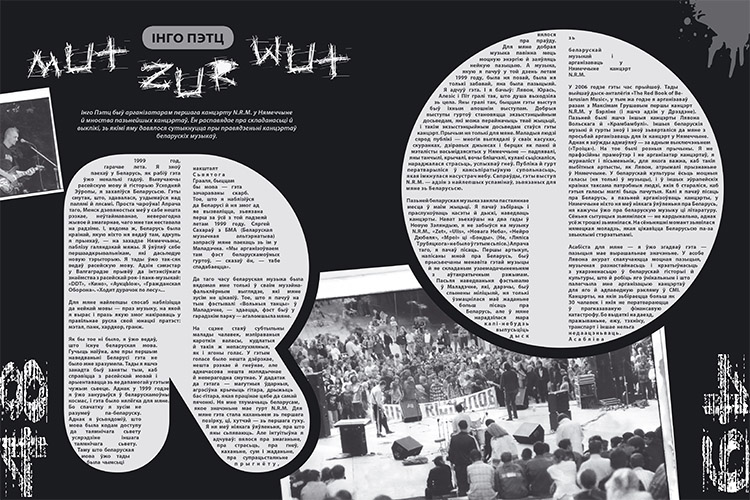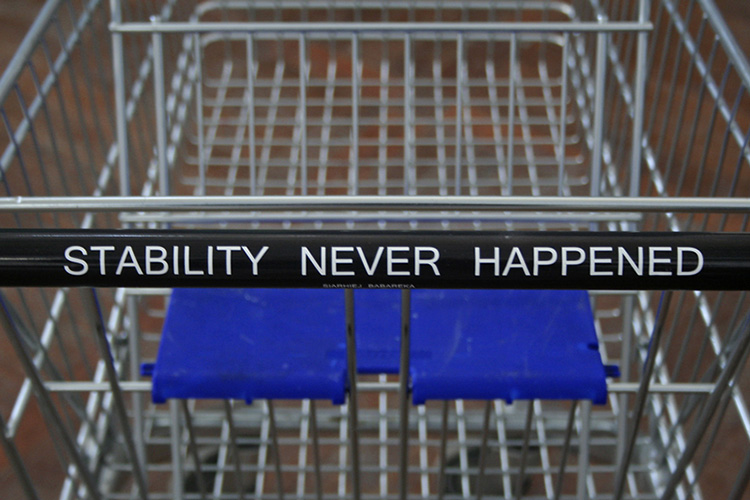
Аўтар: pARTisan, 15/07/2015 | Cult Aktivist SPECIAL
MUSEUM: LOOKING FOR IDENTITIES
Translated into English fragmentary
On June, 18 in CECH art-space the discussion «Museum of the Former Soviet Union: Time for Change?» was held on the occasion of the publication of a new issue of the «pARTisan» almanac dedicated to the theme of the museum in the former Soviet Union. The discussion was attended by the Director of the Memorial Museum-Studio of Zair Azgur Aksana Bahdanava, the artist Ruslan Vaškievič (Ruslan Vashkevich), and a special guest from Ukraine — Juliya Vaganova, the Deputy Director on the exhibition and international activities of the National Art Museum in Kiev. Alaksiej Bratačkin (Alexey Bratochkin) was the moderator.
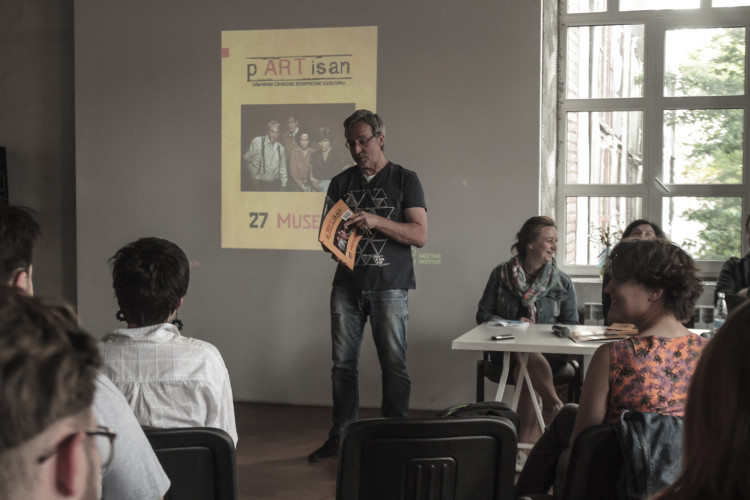
Artur Klinau, editor-in-chief, is presenting the issue. Photo by K.Paliakova
Alaksiej Bratačkin: Good evening! I will highlight the problematic field that we would like to discuss today. The first problem is critical analysis of the legacy of the concept of «the Soviet Museum» from the point of view of different perspectives. Here I consider the issue of «the Soviet» not only in a negative context, because I suppose that now we can interpret it differently and can think, for instance, about the things that were formed in the Soviet era: its accessibility, a museum educational function and others. Looking back at the Soviet, it should be mentioned that in Belarus museums management system, according to Alaksandr Hužałoŭski, one of the researchers of museology, was established in the year of the Stalin’s death — in 1953. It was then when the Department of Museums and Monuments was formed at the Ministry of Culture, and since that moment, with minor changes, this system has been operating.
The second cross-cutting issue of our discussion is political (in its broadest sense) context of museum institutions activities. This encompasses a variety of identity politics which are implemented within the museum space and affect museum institutions, the impact of different ideologies, etc. We must always bear this aspect in mind when talking in general about the museum activity. The third aspect is the commercialization of museums today, or museum marketing: how a museum can «sell» itself, to offer some services, how it can survive when the resources are missing. And the last question is connected with the problem of the internationalization of the Belarusian museums, I mean the way museums take part in international projects, how they borrow their colleagues’ experience, etc.
Before we turn to the agenda, I give the floor to Julija Vahanava, who is going to make us acquainted with the activities of the National Art Museum of Ukraine, and after the presentation we will get straight to the discussion.
Julija Vahanava’s presentation. You can read about the history and transformations of the National Art Museum of Ukraine in the interview with her.
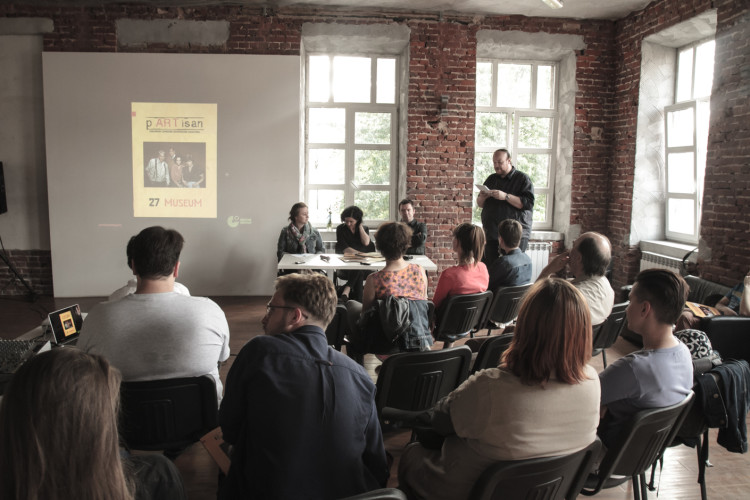
During the discussion. Photo by K.Paliakova
Al.Br.: Our first question is retrospective, it refers to the 1990s-2000s, because serious transformations of the former Soviet Union began during that period. What do you think, what key points in these transformations of the museums can be highlighted? In your opinion, what was the most important for the changes of the museum institution?
Aksana Bahdanava: It is not an easy question for me. I do not know what a Soviet museum or a museum of the Soviet period and a non-Soviet museum are. But if to talk about systematic, radical changes, I have not noticed them. However, as a person who «entered» the museum sector in 1987, and as a museum employee who loves the scientific component of the museum’s activities, I should point out that the study of the subject of the museum has moved into the background, losing its educational activities. The latter, in their turn, have been transformed. Traditional forms of interaction with our visitors (guided tours, lectures) were enriched by the whole range of interactive practices: workshops, forums, festivals, interdisciplinary projects, accompanying or parallel programs presented in the course of the exhibition projects realization. If we try to define how a successful museum looks today, I mean as I see it personally, then the following formula can be presented in percentages: 60 % of success is a strong collection; 40 % is the collection maintenance, that is the team who works with this material.
It is excellent if the team gathers together not only museum experts, but also art historians, artists, historians, designers, architects and writers. This approach is a characteristic feature of our institution’s human resources policy which has already been tested by us and today I can state that it really justifies itself.
Perhaps, it is also due to this that we managed to render the tough model of the memorial monographic museum more dynamic and «responsive». I would really want to hope that our memorial and experimental art site complies with the motto «a museum that changes in the changing world».
Juliya Vaganova: And experiments with memory.
A.B.: Yes, we realized that the experiment in the academic space of the museum is possible, but on condition of the balance preserved between innovations and the museum standard. In the case of the Memorial Museum-Studio of Zair Azgur this balance is kept through the implementation of the initiatives within general integral projects such as «The Place of Memory» and «Modern + classic. Contemporary Art in the Traditional Museum». The contents of the project «The Place of Memory» is rooted in the categories of «time», «place», «action», whereas in «Modern + classic. Contemporary Art in the Traditional Museum» it relies on the understanding and interpretation given by contemporary artists, filmmakers, poets, composers and musicians to the historic past and the creative heritage.
Al.Br.: Ruslan, I have a question to you as to an artist. What is your personal experience of relations with the museum in retrospective? Has anything changed in the museum’s activities recently, as it seems to you?
Ruslan Vaškievič: If we talk about the Soviet times, all the departments of the museum were working scrupulously, the collection was periodically enriched, chief curators and archivists were carefully describing the accumulated property, the guides were taking the visitors around the museum in circles. The funds for the purchase of new works of art were granted. Somehow sluggishly, but nevertheless, inside the museum was alive. From the outside it was a classic cultural and educational attraction for the population. A notable surge in Belarusian museums occurred at the times of «perestroika». The exhibitions of contemporary artists became more active. But then suddenly it was all over — with the change of the director, with the rise of new political times, with some museum employees leaving their posts.
Now the museum is a self-financing company which should pay for itself selling tickets and playing with the public. It is enough to recall wedding photo shoots.
The obligatory «Night of Museums» has become a shameful performance, and this is what spectators themselves openly speak about. And, yes, the most important thing is that for contemporary artists a way to the museum is closed.
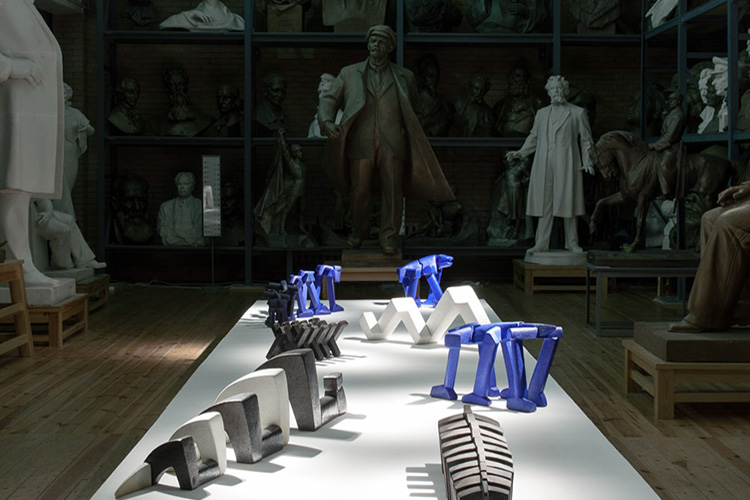
Tamara Sakalova. Some those, another those project. the Memorial Museum-Studio of Zair Azgur. 2013
J.V.: I can also speak both of positive and negative aspects. Here we need to look how the museum relates to other things. When we talk about the museum and the public, then undoubtedly museums have become more open to the audience. Even by offering these «Nights of Museums». Yes, it does turn into a hard entertainment, however it also opens some new formats. On the other hand, we understand that in the Soviet times the museum had a specific ideological function. The Soviet Union apparently collapsed and the ideological function also disappeared giving place to a new one: the museum became such an agency of parties and holidays. We organize «Night of Museums», weddings, the only thing that we lack is probably funerals. We incorporated this mechanism of Western marketing, realizing that there are some positive aspects about it, but still we cannot compete with entertainment industry, thus this model does not work smoothly.
If we talk about Ukraine, a new situation is being formed at the moment, where it is important not to fall into new advocacy and again not to become the propaganda of new ideas, with which you can agree or not, however, such a danger does exist.
Whether it is a national or an anti-national idea, the idea of globalization or any other thesis — one should learn to balance. Still, you should not deceive yourself, we understand that a state museum in any case presents a certain ideology, because it is funded by the state and the things are more complicated here.
If we talk about the relations between the museum and power, some changes really occur, but the authorities are reluctant to agree to accept the new formula, which the museum is trying to bring, in particular to the Ministry of Culture. Until now there has been a situation when the museum has served to the Ministry of Culture, which has its own ideology and cultural policy that the museum has to promote. But now museums tend to take a different position: the museum today primarily works for and serves to the society and therefore the Ministry of Culture should provide such conditions so that this task could be carried out. And not vice versa. Of course, we understand that the authorities resist such a form, and not only they: many people find it hard to realize.

From the Heroes. An Attempt of Inventory. National Art Museum of Ukraine. 2014
Al.Br.: At the same time we are starting to raise an interesting topic — the reception of another’s experience, when museums are built into the global system, borrowing some «external» patterns. And the first thing that was mentioned was museum marketing or an attempt to create entertainment industry, for example, to hold «Night of Museums». This event has been organized in Belarus for a few years so far. But I have the following questions: what problems arise in the course of the reception of this external expertise? Does the system resist? Does the external and «foreign» experience produce a nasty combination with the local context?
R.V.: For me the moment of the personal contact and dialogue with the museum administration has always been representative. For example, the Rumyantsev-Paskevich Residence in Homel is a totally flexible structure with a good team of talented managers who are ready to take a big risk in order to make a cultural event, they are just well aware that the traditional format does not work anymore.
But it has nothing to do with a general cultural policy we have in Belarus, rather, it is done as an opposition to the general institutional «pressure» and thanks to those particular individuals who function within these structures.
A.B.: As for our museum, I can not say that we are beginning to move only after we find major trends and check our course with the course of the flagships of the museum business. Rather, the processes taking place in our institution follow our intuition and personal experience. Often after the event is over we find out a coincidence in strategies and the format of the events at the Museum-Studio of Zair Azgur and at other European museums. So we still find ourselves within the mainstream and we can feel the time.
Almost everything can be handled thanks to the presence of the real strong personality inside the museum. At least one of such figures should exist in a museum. But just knowing the subject-matter and translating this knowledge is not enough nowadays. Whatever the overall structure, the configuration and the landscape are, when the museum has a team of personalities a successful implementation is guaranteed. Of course, the state policy in the field of museology would only add to success. But my personal experience shows that decisions are still taken at a personal level, inside the museum.
J.V.: We understand that the museum director solves many questions. The point is whether the director is building a monument to him/herself, satisfying one’s personal ambitions, or this director knowingly steps back, advancing the team members, and being aware that the stronger each team member is, the more powerful the director becomes.
If to speak about technologies that reach us from the West, we quite often approach these innovations as instruments. Of course, we must make use of different experiences, of course, marketing is good, but if we look at Western museums, now they very actively criticize such «party and holiday» approaches. The same stands true for the introduction of new media technologies, which are now popular, but has already been criticized by our Western counterparts, because they begin to replace the object itself. They are refusing to speak on this topic, whereas we are still trying to introduce plasma screens, put them in rows with paintings, that is, ascribing them the same value as works of art.
Or, for example, we introduce audio guides, while in the West the criticism is starting, which points out that those are very directional in visitor’s guiding and deprive him/her of the possibility of encounter the object of art independently, taking away one’s desire to think on their own.
Al.Br.: Now we are talking a lot about how the audience reacts and how it perceives what happens in museums. When I was writing an article about our Museum of the Great Patriotic War, I found a statement made by one of the museum employees where she said that the audience was not ready to accept changes due to their low educational and cultural level, thus we cannot experiment, for example, offering different perspectives on the history of the war. This is the attitude that the museum demonstrates — looking at the audience from the «above».
And at the same time, when I was presenting a public lecture on historical museums outside Belarus, one of the theses argued that today a person has a lot of different identities, and the museum has to deal with this set, to offer some other things, various interpretations of the events for further discussion and so on. Thus I have a question to each of you. I would start with Ruslan. In your opinion who do you work for? What kind of museum visitor is being formed in Belarus?
R.V.: I have always been interested in the inversion that occurs alongside with contemporary art interventions into a government house. After all, with «another» project «another» audience comes in. So sometimes one happens to influence the perception of even regular visitors of an «ordinary» museum. It is a conscious shift of perspective, blurring the boundaries of «eternal-temporary», destruction of the stabilized once and for all order — important components of my own interventions. I am very curious to read reviews on the exhibition afterwards; there is, of course, enough of everything, but mostly — a collective self-portrait of the audience, and suddenly you find a review written by some elderly lady admits having experience some revelation and want to find the author to thank him personally.

Ruslan Vaškievič. Museum project. National Art Museum of Belarus. 2011. Photo from n-europe.eu
Al.Br.: Aksana, Zaire Azgur’s Museum is a museum of the Soviet author. We also know that in Belarus there is a big problem of interpretation of the Soviet past, the presence of any consensus framework for its perception. How does the museum manage to deal with the problematic identity of the Soviet past?
A.B.: Initially, we had to identify the space of the Memorial Museum-Studio of Zair Azgur ourselves. We came to understanding that this is the museum of the epoch and the museum to the epoch at the same time, a great museum at a small site. Accordingly, the following themes are given priority: the origins of the Belarusian sculpture school, the Belarusian school of sculpture of the XX century, the sculpture as a form of art. We also work with philosophical issues — the artist and society, the artist and the state, the artist and the model at an example of private biographies, etc.
Al.Br.: Juliya, Ukrainian situation today is very complicated, there is a high degree of politicization of the society with war actions that still evolve in the country. To what extent can the museum preserve its professionalism in such conditions? How to find a strategy of dealing with different types of audience, avoiding the radical involvement that would damage the professionalism?
J.V.: Firstly, to preserve the professionalism and avoid propaganda one must understand that people who attend the museum are not stupid, so you need to talk to them on complex subject-matters and using a complex language. It is necessary to take a position side by side with the public. In the project «Heroes» such a mise en scene took place. One of the visitors claimed: «What right do you have to show Lenin and Stalin? Give me back the money for my ticket!» Another visitor heard it and said: «I’ll give you the money if you do not understand what they wanted to say, and if you want, I can even explain it to you!» The third visitor got involved into the discussion, saying: «And what do you have to offer? To kill people like they did in the 1930s? Then how would we differ from the red commissars and the period of terror?» And here we must constantly refer to and explore the history and not to forget it. The problem is that we do forget it very quickly.
Now in Ukraine a law on de-communization has been adopted, which is keenly debated within the cultural circles, because there are a lot of controversial moments. At the same time we showed the project «Special Fund». It was formed in the 1937-39s, there the formalists’ works were brought that were made by people who were considered as enemies, as well as by those who used to «have tea» with them. Apart from the museum staff and the director, no one had had access to them before, and the first time they were made visible happened immediately after the war, it was done for the inventory, then they were hidden again, and then in the 1980s and again the access to the collection kept in these funds was limited, since the end of the 1990s there was a process of the works’ restoration. And just recently, these works have been shown to the public, and the idea’s exhibition also presents a reflection on such a political public demand as decommunisation. Yes, of course, it should occur, it is necessary to make the KGB archives available to the public, etc. But if we talk about banning the Nazi and Soviet symbols, then comes the clause — apart from text books and works of art, where these symbols are used; in case — as it is mentioned in another clause — these works are not propaganda of the regime … But who decides whether they are propaganda or not? And what can be done with these works — should they be destroyed or not?
We must look for approaches, strategies of extremes avoidance, at least for cultural educational institutions, offer the public to reflect on their own and to draw personal conclusions. But in no way fall into extreme politicization.
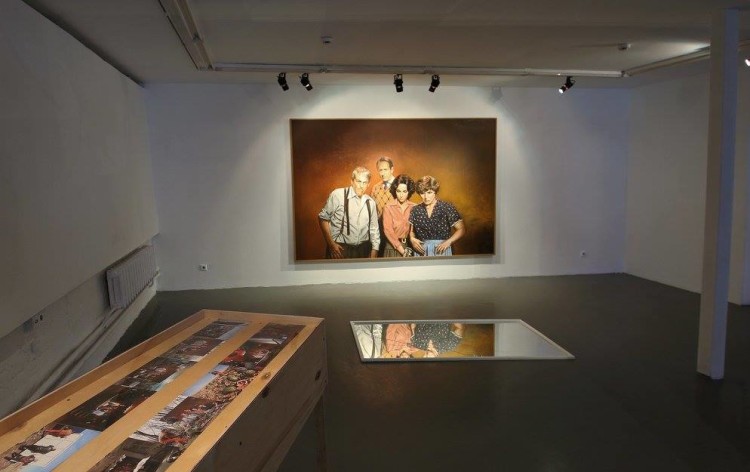
Ruslan Vaškievič. Not looking at anything project. 11.12 Gallery / Vinzavod, Moscow. Photo from the R.Vaškievič archive
Al.Br.: Let me summarize the results of our talk. We have discussed the problem of the transformation of the museum sector within the post-Soviet space and talked about it in a wider context. If to recall today some productive strategies and changes, we can distinguish at least three aspects. Firstly, we are talking about a global shift of the coordinates within the post-Soviet space, when it is not anymore a state, and a museum that performs the functions of propaganda and ideology, in fact, repressive ones, and somewhere nearby there is the society which must be «influenced» on, but today the museum and society interact differently. Whereas the state performs rather the function of the resource.
Secondly, there is another important aspect — an interdisciplinary approach to museum functioning, and in Minsk, for example, projects where people from different disciplines get together and organize an exhibition or something like that are getting popularity. And finally one more aspect — the changes inside the museums themselves: in the approach to dealing with the visitors, to the audience segmentation where different identities and demands are taken into account, the attempt to preserve the professionalism under difficult political conditions. One should also mention that the museum is losing its classic «educational» function and its employees act as mediators between visitors and collections.
That is, a museum as a communication platform appears, and if we talk about the Belarusian context, the communication is that very thing we lack, and museums could work exactly like that.
pARTisan, June 2015.
Translated partly by Volha Bubič.
Opinions of authors do not always reflect the views of pARTisan. If you note any errors, please contact us right away.



